La Sierra a La Selva
As most Ecuadorians are happy to tell you, this albeit small country nevertheless has a lot of diversity of climate. It is generally divided up into three regions, la sierra (the mountains) la selva or el oriente (the eastern jungle) and la coasta (the pacific coast) and if you really want to be thourough, there are also the Galapagos Islands, which are kinda their own thing, but certainly are also part of Ecuador. Quito, as "the highest official capital city in the world" (thanks Wikipedia) is most certainly in the mountains, and the "beach thing" was most certainly on the coast, so the only region that we hadn't seen yet was la selva- the Ecuadorian chunk of the famous amazonian rain forest. Since we were to have a long four day weekend because of "día de los difuntos" (day of the dead) celebrations, we decided to use this time to complete our tour of the 3 regions.
The Monday after the camping trip, those of us who had gone were to bring our rented sleeping bags and yellow fever vaccination certificates to Rodolfo's office before class. I had assumed that yellow fever must have been among the many vaccines I had gotten before getting on the plane and arriving in this country, but as we discovered later, I hadn't gotten that one, since I was told I wouldn't need it in Quito. The thing is that not only is it best to avoid this potentially fatal illness by way of vaccination when traveling to tropical rain forests, the scientific research station owned by the university also doesn't let you in without the certificate saying that you have it. It was Monday, and I didn't have it-great. So after getting some money, Rodolfo and I hopped in a taxi and headed to the historic district where there is a vaccination clinic.
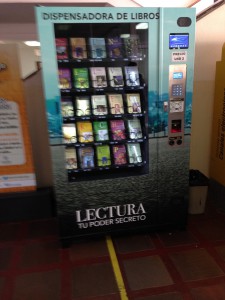
According to the internet, the vaccination is not actually active until 10 days after you get it, and if we were leaving that Friday…but the station director said he would let it slide. After a painfully slow ride through congested morning traffic, we finally arrived at the clinic, where it was a remarkably easy process: upstairs, "no I am not allergic to chicken" (apparently that indicates that you will have problems with the vaccination too-I didn't even know you could be allergic to chicken…) and boom, I was vaccinated! We then went back downstairs to get the certificate, which was as free as the shot had been (absolutely) which was a nice plus to being unprepared-I saved hundreds of dollars spent by my compañeros who got the shot in the US-might have been better to get it done a week earlier, but…
As we were winding our way out of the centro historico, we stumbled upon the highly formal ceremonial changing of the presidential guard, and in fact the president himself, overlooking it all from his balcony in la plaza de la independencia.
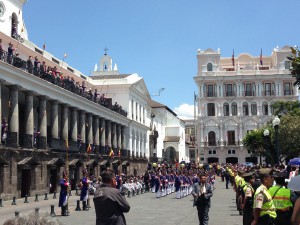
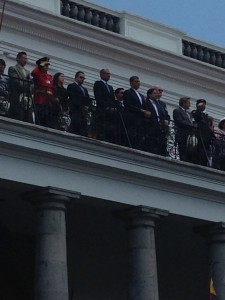
The rest of the week was filled with scurrying around trying to get all the homework done before missing class to leave early Friday morning. Wednesday I skipped aerial silks to go to the colada morada (which is what Ximena made in that gigantic pot a few weeks go) and guaguas de pan event in the international programs office. Since we would be in the jungle during the day of the dead festivities, and would not have a chance to eat these traditional foods.
To give some context, colada morada is a hot thick drink made from herbs, blackberry juice (I think…) and with pieces of strawberries, apples and pineapple. It is delicious but very sweet after drinking two mug fulls, as I discovered. Guaguas de pan are pieces of (often jam-filled) sweet bread shaped like babies (guagua, which is pronounced "wawa" is the word for child in the indigenous language of Kichwa) and these represent the rebirth that is intimately connected with death in many indigenous traditions.
I had a nice long walk/wellie-buying adventure with Sarah, and when art class was canceled that evening, I printed off the group project essay about the obscure mural that we had researched, and was able to accompany Sarah and another Spanish class classmate to our French classmate's apartment, where he made us a delicious crepe dinner (if a Frenchman offers to cook you crepes, you accept, if at all possible, right?) and we spent a lovely evening chatting (mostly about Paris, where neither Sarah nor I knew enough to contribute much of anything…)
Thursday brought an Otavalo-style pants (Otavalo is the indigenous community we visited all those months ago, the first weekend we were here) buying expedition with Tyler, and a skype information session about the wonders of the very first Earlham Ecuador program (recruiting for next year) in the afternoon. There was a minor freak-out later that night when I realized that my re-loadable credit card had no more money on it (and I couldn't remember how to reload it online) and I couldn't find my actual credit card-even after turning my room upside down. I called my lovely family late late at night, and they arranged to go to the bank and reload it for me before I was to leave the next morning-gotta love em.
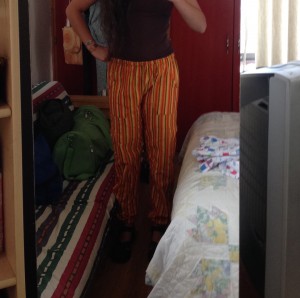
Our group (James, Michelle, Minori, Tyler, Sarah, our Ecuadorian friend/anthropologist who is studying us Veronica, our fearless leader Rodolfo and I) met bright and early at the university's main entrance to await the first in many stages of transport we were to use that day: taxis to the airport. They were worryingly late in coming, but come they did, and we arrived in plenty of time at the airport that we had arrived to this country in almost exactly 3 months before. When we got there, I discovered where my other credit card had run off to…INSIDE MY PASSPORT!
After deciding against buying some horrifically overpriced (that is, what you would pay anywhere in the US…) airport food we boarded the plane, and I had a nice chat with Minori, that seemed to just be getting started when we were already landing in the Coca airport.
Stepping off an airplane to a radically different climate than the one in which you got on the plane is always a shocking experience, and I was not quite prepared for the wall of hot humidity that instantly enveloped me as I walked out of the doors. I don't know what I was expecting, but after leaving the cloudy chill of Quito, this weather that instantly coated me in a fine layer of sweat was certainly more stark a contrast than I was prepared for. After collecting our bags, and attempting to reconcile ourselves to the change in climate, we got into truck-taxis that were to take us the next leg of our journey. After a pit stop for some empanadas (rather longer than expected, since we got to talking about politics) we continued on our way, which was eventually stopped by the river we needed to cross by canoe. After a wait, our next mode of transport arrived, and cross the river we did. After scanning our bags and showing our passports, we then got in our fifth form of transportation for the day, a 15 passenger van, which at long last took us to the scientific research station in Yasuní national park, owned by our very own PUCE (Potificia Universidad Catolica del Ecuador).
We were shown to our blessedly air-conditioned rooms, and told that dinner would be at 7 sharp (we took that with a large grain of salt-'this is Ecuador' we thought, '"sharp" means within half an hour') after dinner we fought off our travel fatigue to have an abbreviated version of Rodolfo's class before drifting off to sleep.
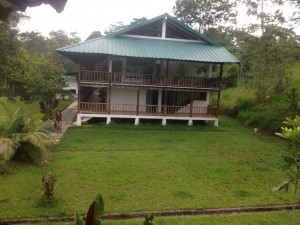
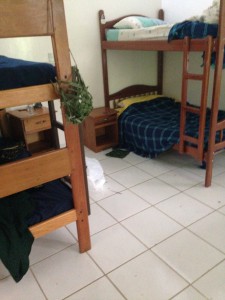
In the evenings we would be amazed by the insects and their size while going to dinner:
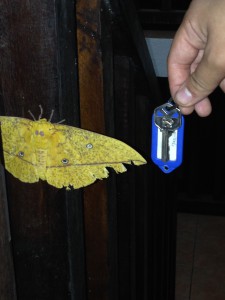
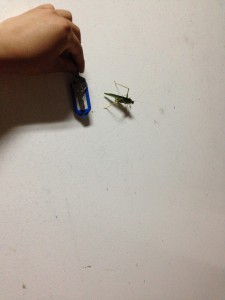
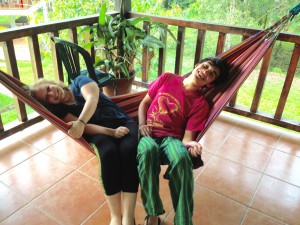
The next morning we rose for breakfast at 7 (they weren't kidding about that punctuality thing-we were told off for arriving 5 minutes late—we think it is these exact sciency types that are actually punctual in a culture that seems to suffer remarkably little from their chronic tardiness) After breakfast, we prepared for our first excursion into la selva. As we got fitted for life jackets to prepare for the canoe ride that was to proceed our hike, we saw these guys:
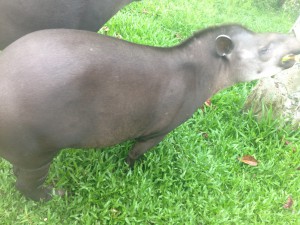
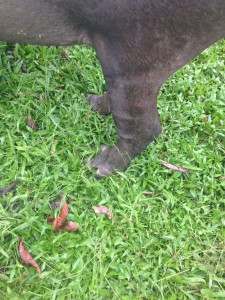
We then boarded the canoes.
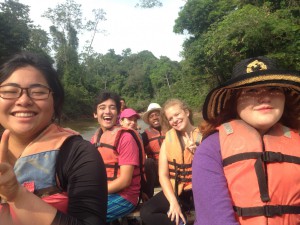
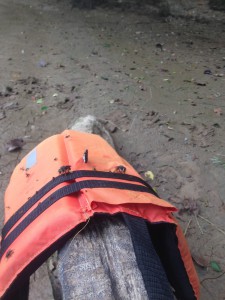
After a windy ride in the motorized canoe, we arrived at an extremely muddy riverbank, where we began our hike with our native Waorani guide. It was shocking in some ways the odd degree of familiarity there was while walking through the jungle. Despite its obvious differences of flora, I was struck with the perhaps obvious realization that it was still a forest, and walking through the forests (albeit those of the United State's upper Midwest) is nothing new to me. I think I just had this image of the Amazonian rain forest as this utterly exotic terrain, completely foreign- almost of another planet. The fact is (despite the myriad differences) at the root of the thing, a forest is still a forest—anywhere in the world, just like people are still just people, no matter how seemingly different.
We ended up having lots of free time in the afternoons, after returning from our muddy, sweaty adventures, and we made the most of this time (I was sorely tempted to use the Spanish verb "aprovechar" there, since it seems to have a much richer meaning that "take advantage of"…) to hangout in one of our air conditioned rooms, chatting and bonding the hours away.
In the evenings, we watched movies vaguely related to Rodolfo's class. After the first one Minori asked "Is this one going to be about indigenous people again? Does that mean they are all going to die again?" which pretty well sums up the representation of the bloody but historical plots.
Sunday's excursion took us a little ways into the woods and then to a large metal tower/cage thing. We strapped on our harnesses and helmets and climbed and clipped our way up one by one, as high as our various comfort levels allowed. The view from the top was indeed stunning, but perhaps more so, were the bugs. The incredibleness of the view showed the expansive forest spreading out in all directions, as we ended up just even with the tallest of the trees, rising above the main canopy of the jungle-really wonderful. Meanwhile, the gnats provided a very distinctive ambiance in the form of that infuriating buzzing sound in our ears, as they formed a constant whirring cloud around our dripping faces, not infrequently flying directly into our eyes, for added emphasis. We all developed different coping strategies, involving hoods, elaborate patterns of waving our grippy climbing gloves in front of our faces, applying a visible layer of bug spray to the helmets and everything else, turtling inside our shirts, and occasionally shrieking in fury.
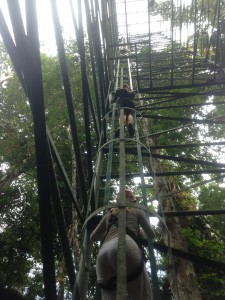

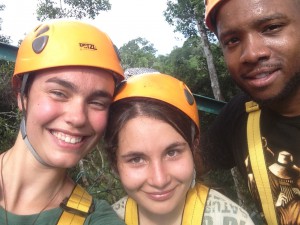
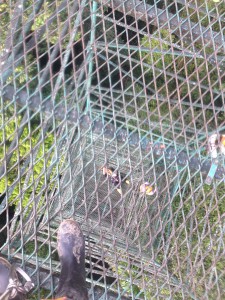

I honestly can't remember which afternoon it was now, but one of the days, after returning and removing the mornings worth of grime from our bodies, and eating some lunch, we set out in the van to visit the nearest Waorani community. The Waorani are one of the biggest tribes in the area, and the three anthropologists who were staying at the research station with us are working with the community, because there are some interesting cultural changes going on right now. The tribe's first "contact" with western/mestizo/vaguely europeanized culture was not until the 1950s. Before that time the people hunted with their traditional blow-guns, and wore their traditional (minimalist if existent clothing and jewelry-because who really wants to wear cloths in that humidity?) and only about 65 years later, the youth now have cell phones and Facebook, which is sure to cause some interesting cultural upheavals.
We arrived in the middle of a soccer game, and were shepherded through the field to where some of the artisans had their wares layed out for us to buy, such as earings made of red and black seeds (bought some of those for Ximena, whose birthday I was missing because of the trip) and other such treasures. We then were shown a chant and dance done by some of the women, one of whom had a monkey clinging to her neck and hair the entire time we were there. We then got a brief tour of the traditional lodge, and then proceeded to spin around and play with some of the energetic and fearless youngsters, until it was time to go.
Monday took us on a walk past another river, through impressive amounts of mud, and past large trees. Our guide was making a basket woven out of palm leaves, so I picked up the other half of the frond that she had ripped off and wove a fan for myself, following suit. I also collected some leaves that are allegedly used as shampoo by the Waorani.

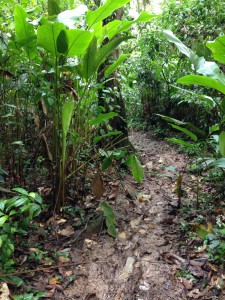
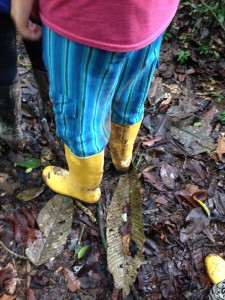
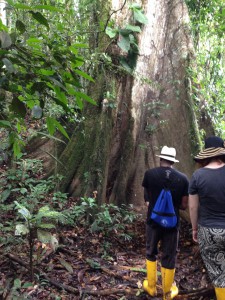
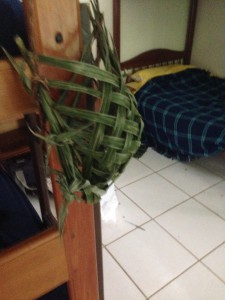
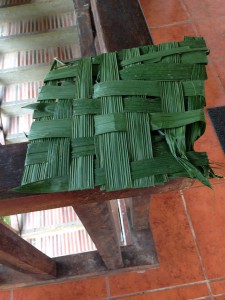
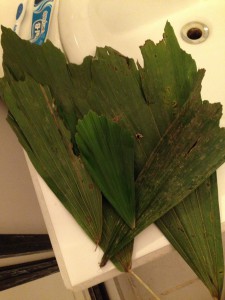
Before we knew it, it was Tuesday morning, and our long weekend was drawing to a close. I decided to use those handy dandy shampoo leaves to at least start the day clean before a long sweaty journey.
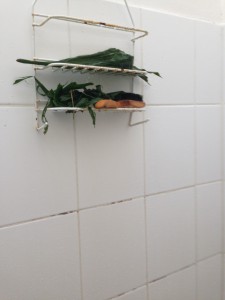
I was told to twist and mash the leaves, and that a soapy liquid would come out. Upon doing this I was indeed greeted with a greenish slippery/sticky liquid that I rubbed into my scalp as best I could…After marginal success in my endeavor, and our punctual breakfast, we loaded our stuff into the vans once more for the return trekk.
We ended up having a lot of time to kill in Coca before our flight (since the van to canoe to taxi truck part of the journey was much less full of delays than when we arrived. After a mediocre but very expensive lunch in a hotel (it was worth it because we could leave our stuff there while we explored) we took a stroll along the river, bought some jewelry at the artisan market, hung around the cultural museum where we saw some of the Waorani community members we had met photographed in an exposition. It was eventually time to go back to the tiny airport, say goodbye to the humidly and board the plane back to Quito once again.


I have always loved the stomach dropping feeling of the moment of takeoff and landing an airplane, it never fails to be exhilarating, perhaps because I don't experience it all that often. I couldn't help snapping photo after photo, since I hadn't had a window seat on the other flight, so here are only a few, if you can believe it.
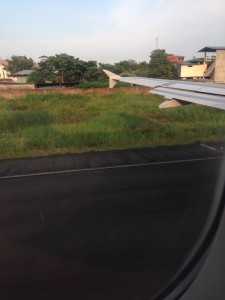
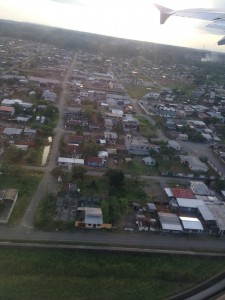
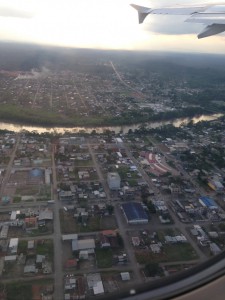
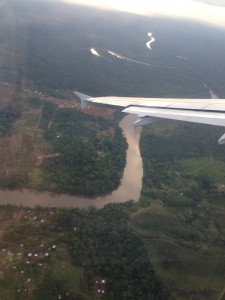
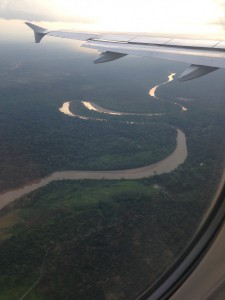
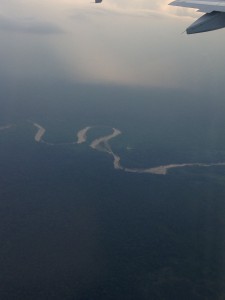
After a bit of homework that I hadn't done over the weekend, I looked out the window, and we had already arrived back to the now familiar landscape of la sierra of Quito.
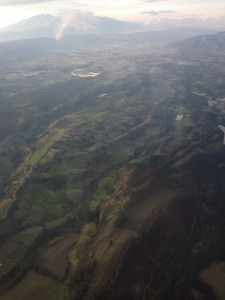
The feeling of stepping off the plane to the refreshingly chilly wind and cloudy evening of what I realized really did feel like a home to me was surprisingly contented. Whereas returning to Quito after the beach had brought a heavy dose of melancholy, this return really felt like I was back were I belonged again-glad I had gone, but glad to return as well.
I returned home to a much needed shower after the fresh sweat of the journey and the dubious state of cleanliness that the shampoo had left my hair in. Soon after eating some dinner, and recounting of some of my adventures to Ximena and Gustavo, I collapsed (without blogging-hence you are getting the story only now) into my own bed again.
